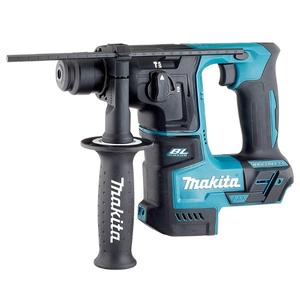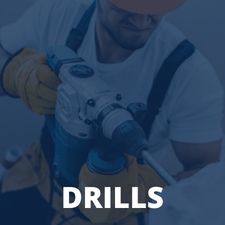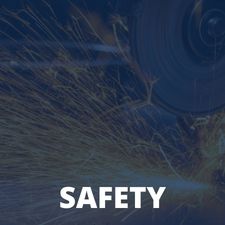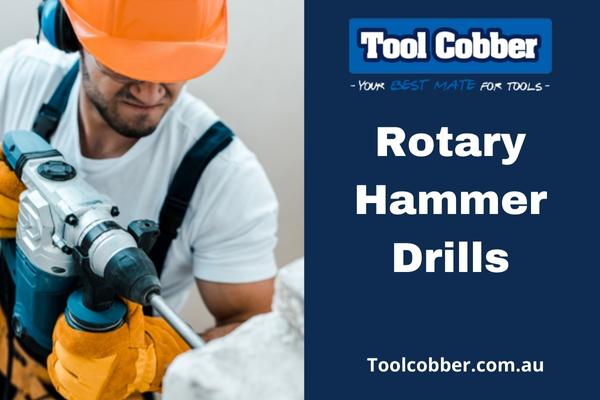
The Best Rotary Hammer Drills Australia, Information, Buyers Guides, Comparisons and Reviews
Rotary hammer drills (also known as pneumatic hammer drills, Kango’s, or Hilti‘s) are primarily designed for heavy-duty masonry work. This work can include boring huge holes into structural concrete, ripping up ceramic tiles, and even light demolition work. They also have the ability to drill through materials such as wood, metal, and plastics.
Although regular hammer drills possess the ability to drill through masonry, the force rotary hammer drills exhibit belittles this ability. The difference is in the hammer mechanism of each type of drill. Hammer drills rely on a mechanical hammer action, whereas rotary hammer drills utilise a pneumatic hammer action.
Rotart Hammer Drill Top Picks
| IMAGE | PRODUCT | DETAILS | ||
|---|---|---|---|---|
|
Best for Professionals 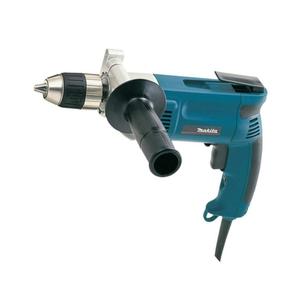
|
Best for Professionals
|
Makita DHR202Z 20mm SDS Plus Rotary Hammer
|
Features
|
Check Price at Amazon Check Price at Toolmart Makita DHR202Z 20mm SDS Plus Rotary Hammer Review Makita DHR202Z 20mm SDS Plus Rotary Hammer Review |
|
Best for Vibration Reduction 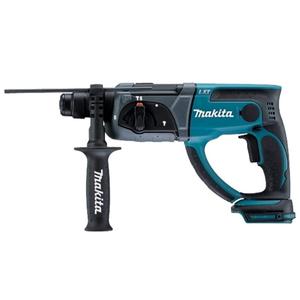
|
Best for Vibration Reduction
|
Makita DHR171Z 17mm SDS Plus Rotary Hammer
|
Features
|
Check Price at Amazon Check Price at Toolmart Makita DHR171Z 17mm SDS Plus Rotary Hammer Review Makita DHR171Z 17mm SDS Plus Rotary Hammer Review |
|
Best for Cell Life 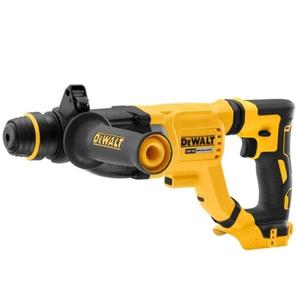
|
Best for Cell Life
|
DEWALT DCH263N-XJ 28mm SDS Plus Rotary Hammer
|
Features
|
Check Price at Toolmart DEWALT DCH263N-XJ 28mm SDS Plus Rotary Hammer Review DEWALT DCH263N-XJ 28mm SDS Plus Rotary Hammer Review |
|
Best for Impact Rate 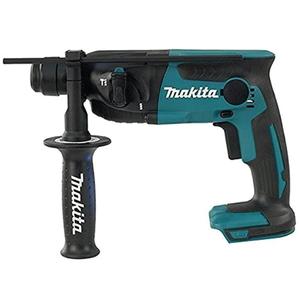
|
Best for Impact Rate
|
Makita DHR165Z 16mm SDS Plus Rotary Hammer
|
Features
|
Check Price at Amazon Check Price at Toolmart Makita DHR165Z 16mm SDS Plus Rotary Hammer Review Makita DHR165Z 16mm SDS Plus Rotary Hammer Review |
|
Best Sub Compact 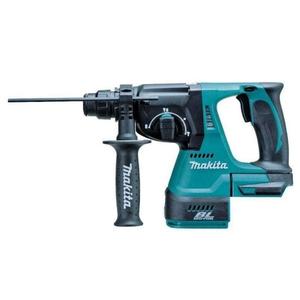
|
Best Sub Compact
|
Makita DHR242Z 24mm SDS Plus Rotary Hammer
|
Features
|
Check Price at Toolmart Makita DHR242Z 24mm SDS Plus Rotary Hammer Review Makita DHR242Z 24mm SDS Plus Rotary Hammer Review |
|
Best for Overhead Projects 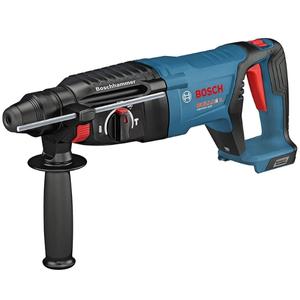
|
Best for Overhead Projects
|
Bosch GBH18V-26DN 25.4mm SDS Plus Rotary Hammer
|
Features
|
Check Price at Amazon Bosch GBH18V-26DN 25.4mm SDS Plus Rotary Hammer Review Bosch GBH18V-26DN 25.4mm SDS Plus Rotary Hammer Review |
|
Best for Durability 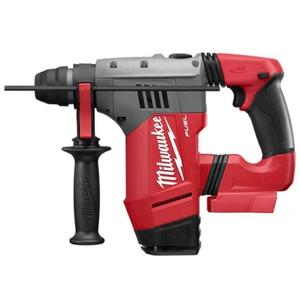
|
Best for Durability
|
Milwaukee M18CHP-0 28mm SDS+ Rotary Hammer
|
Features
|
Check Price at Amazon Milwaukee M18CHP-0 28mm SDS+ Rotary Hammer Review Milwaukee M18CHP-0 28mm SDS+ Rotary Hammer Review |
|
Best Lightweight 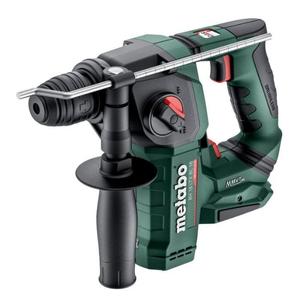
|
Best Lightweight
|
Metabo BH 18 LTX BL 16mm SDS Plus Rotary Hammer
|
Features
|
Check Price at Toolmart Metabo BH 18 LTX BL 16mm SDS Plus Rotary Hammer Review Metabo BH 18 LTX BL 16mm SDS Plus Rotary Hammer Review |
|
Best for Concrete 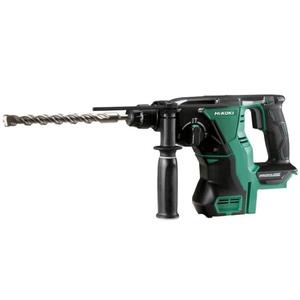
|
Best for Concrete
|
HiKOKI DH18DBL 26mm SDS Plus Rotary Hammer
|
Features
|
HiKOKI DH18DBL 26mm SDS Plus Rotary Hammer Review HiKOKI DH18DBL 26mm SDS Plus Rotary Hammer Review |
|
Best Budget 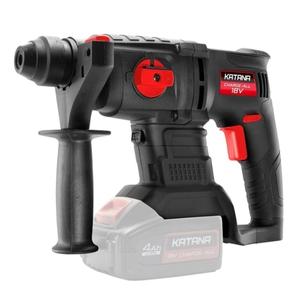
|
Best Budget
|
Katana 220002 18mm SDS Plus Rotary Hammer
|
Features
|
Check Price at Toolmart Katana 220002 18mm SDS Plus Rotary Hammer Review Katana 220002 18mm SDS Plus Rotary Hammer Review |
The idea behind pneumatic hammer action is that it creates high impact force, and less wear on the drill’s internal components. It works via a small piston that is operated by the drill’s motor. This piston compresses air against a metal spring-loaded plate that exerts an immense force on the drive shaft of the drill. Each time this occurs, it is considered a blow. The speed of these blows is measured in blows per minute (bpm).
You will notice that the ‘bpm’ value of a rotary hammer drill is much less than that of a regular hammer drill. This is because a rotary hammer drill exerts more force through on its drive shaft per blow, and also because it is a much slower process.
Each blow from a rotary hammer drill is measured in Joules (J). The higher the value of this impact energy, and the higher the ‘bpm’ value is, the faster a rotary hammer drill can drill through masonry.
See Full Range Of Cordless Rotary Hammer Drills
See Full Range Of Corded Rotary Hammer Drills
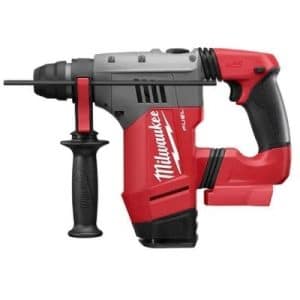
Milwaukee M18CHP-0 18V 28mm FUEL Cordless SDS Plus Rotary Hammer Drill Check Latest Price
Rotary Hammer Drill Features
Rotary hammer drills feature many different components, and having a sound understanding of these plays an important part in the purchasing process. Knowledge of these parts also aids in the efficient and effective use of the tool.
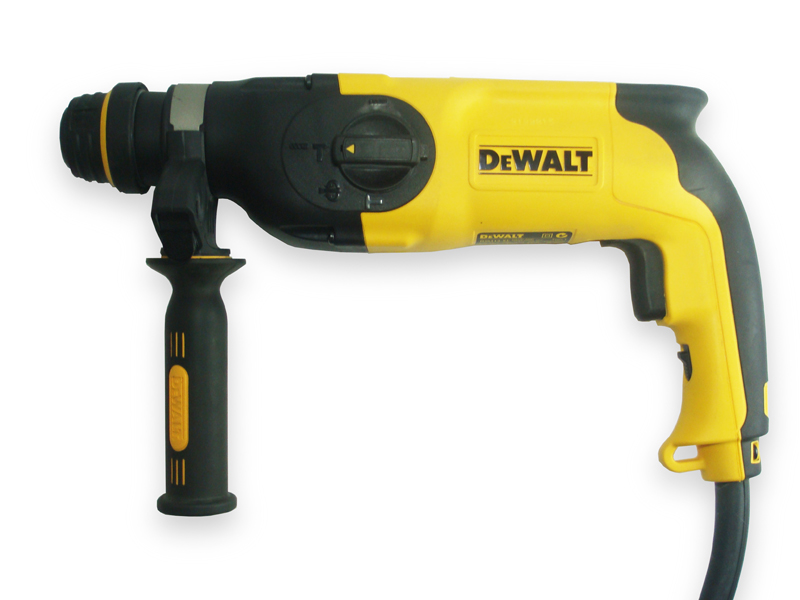
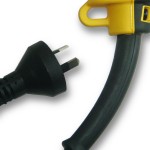 Rotary Hammer Drill Power Sources
Rotary Hammer Drill Power Sources
The power source is the component that provides the tool with electricity. On rotary hammer drills, this is done through a wired connection to a mains power supply. In Australia, rotary hammer drills operate off mains power (240V) through a 10A socket.
Cordless rotary hammer drills that are powered by a battery and a charger are also available and bear very similar features to those described below. They are generally not as powerful as their corded equivalents and require regular charging, but are usually considerably light in weight and have unmatched portability.
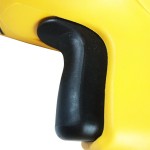 Switch
Switch
The switch allows the electricity from the power source to flow through the tool. All portable drills are activated by a trigger switch. When this trigger is pressed, the drill will begin to operate. The most common is the variable speed trigger. The further you depress this trigger, the faster the chuck rotates.
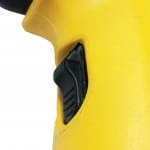 Lock-On Button
Lock-On Button
This button can be pushed while the trigger is depressed and the trigger will lock on to that set speed. To cease this function, simply pull the trigger.
Make sure this button has been released prior to disconnecting the tool. If not, the tool will begin to operate upon reconnection and may result in injury. For more safety recommendations, click here.
Forward/Reverse Switch
With a flick of this switch, the drilling direction changes to allow for forward and reverse motion (right and left motion respectively). This feature is only found on some rotary hammer drills.
Rotary Hammer Drill Motors
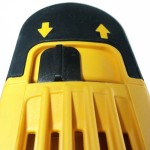
Motors are the main component of all power tools, and are the component that converts the electricity into motion. The power that motors produce is measured in Watts (W). Motors used in portable electric drills are called AC motors (they are also known as universal or series motors).
Rotary hammer drills can have motors with an input power of between 400W and 1500W, and can weigh anywhere between 1.8kg and 12kg.
Many manufacturers will state only the input power of the drill, as this is the larger and more impressive number. This value is actually just an indication of the demand a tool will place on a power outlet under normal operating conditions. The power output at the chuck, though, is significantly less than the input power. This is due to the efficiency of the drill’s internal components, and how power is transferred through the machine. Generally speaking, higher quality tools have greater efficiency and require less input power to produce the same power output. Therefore, although it is uncommon for most manufacturers to include a power output value, it is a much better way of comparing tools.
Most professional quality tools will have a round port on either side of their housing. These ports give simple access (with a slotted screwdriver) to the most frequently wearing component of any tool – it’s brushes.
Some models also come with a soft start motor for containing the start up reaction force of the drill.
Transmission
Also known as a gearbox, transmissions dictate the speed range (revolutions per minute, or rpm) that a drill can operate at, and the corresponding torque (or turning force) that it can produce.
Transmissions can contain single or multiple gears that are driven by the motor. If a small gear is used in the transmission, then rotary speed will be high but torque will be quite low. If a large gear is used, then rotary speed will be quite low, but torque will be high.
Electric drill accessories come in many different sizes, and all have a recommended speed that they have been designed to operate at. To accommodate these requirements, you must have a drill that has both enough torque and enough speed to handle the accessory.
To acknowledge this fact, manufacturers will state the maximum drilling capacities that a drill is capable of drilling into various materials. These materials are wood, metal, and masonry.
Because of this style of hammer action, rotary hammer drills do not require excessive speed to operate effectively. Therefore, they only have one gear that is designed to perform at speeds of up to around 1500rpm.
The optimum drilling capacities of drills are where they will deliver their best performance. If you halve the drill’s maximum drilling capacity, it will give you the optimum drilling size, and is the size of hole you should be most frequently drilling with that drill.
It is quite common for larger units to have a small access point to the grease that lubricates the transmission. Access to this grease is achieved via the included pin spanner. This grease should be replaced after approximately 50 hours of accumulated use.
Torque limiters (or clutches) are also quite common on larger units to stop injury to the user if the drill bit jams during use.
Mode Switch
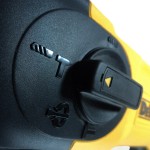
A mode switch allows users to choose between different drilling modes. There are two different types of rotary hammer drills, and they are each known by the number of modes they possess.
Two-Mode Rotary Hammer Drills
Two-mode rotary hammer drills are named as such for the two modes they possess – rotary drilling and rotary hammer drilling.
These drills are typically the smallest type available, but still pack more than enough punch to accomplish most repetitive masonry tasks with ease. They are also an excellent size for most wood and metal tasks (with the use of a keyed chuck adaptor).
Their two modes are illustrated by the following symbols.
 | 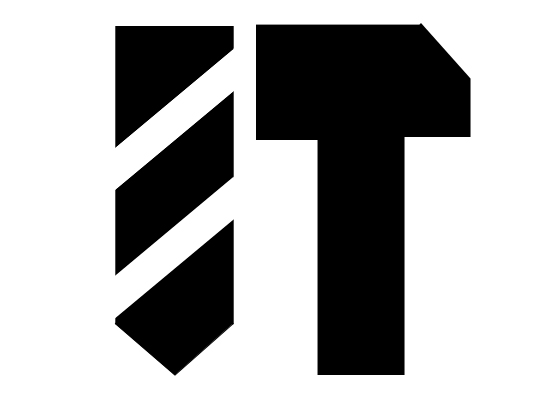 |
|---|---|
This mode allows for powerful rotary drilling. | This mode engages a rotary hammer drill's pneumatic hammer action. |
The impact energy of two-mode rotary hammer drills tends to range from about 1.3 – 2.5J, and they can operate anywhere up to 5000bpm. Maximum drilling capacities in masonry are about 20mm, in metal they are normally 13mm, and in wood they are about 30mm.
Three-Mode Rotary Hammer Drills
Three-mode rotary hammer drills can perform normal rotary drilling, rotary hammer drilling and chiselling – all with the flick of a switch. This chiselling function (basically rotary hammer drilling without the rotation) is a great option for light breaking work and jobs like bathroom renovations.
They feature two more symbols on their mode switch, and these are illustrated and described below.
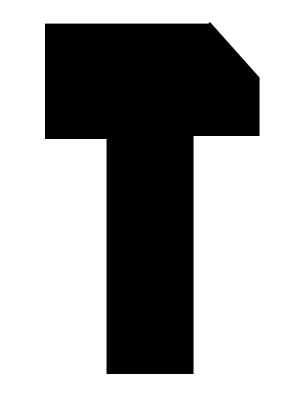 | 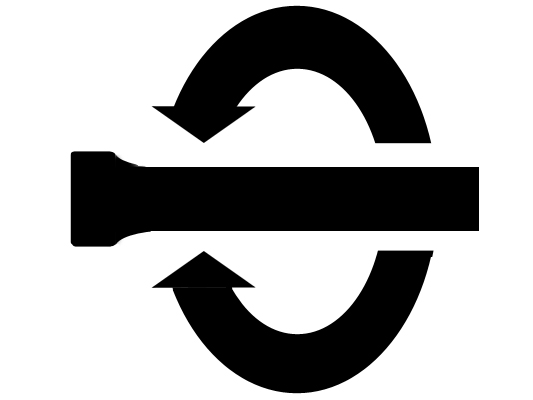 |
|---|---|
This mode acts like an electric chisel, hammering without rotation. | This mode exists to enable you to straighten a chiselling bit before engaging the chiselling mode. |
Generally larger than two-mode’s, three-mode’s have between 2.5 and 6.5J of impact energy, and up to 4500bpm. They are capable of drilling up to 28mm into masonry with a drill bit and up to 90mm with a core cutter, up to 13mm into metal, and up to 32mm into wood.
Larger two-mode hammer drills are also available from some manufacturers. These are only capable of rotary hammer drilling and chiselling, and do not have the capacity to perform normal drilling tasks. They can exhibit up to 20J of impact energy, and can produce up to 2200bpm. They are capable of drilling up to 52mm in concrete with a drill bit and up to 160mm with the aid of a core cutter.
Rotary Hammer Drill Chucks
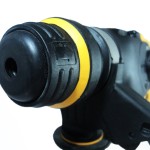
The chuck is the part of the drill that grips drilling accessories. The transmission powers the drive shaft and on the end of this shaft is the chuck.
Rotary hammer drills are fitted with SDS (Special Drilling System) chucks. These chucks are made out of high quality plastic, and lock accessories that have an SDS shank into place.
There are different sizes and styles of SDS chucks, but all rely on the same principles. The two most common styles are SDS-Plus and SDS-Max, and each has its own corresponding drill bits. SDS-Plus is the standard for lighter-duty models, and SDS-Max is only found on the larger and heavier units.
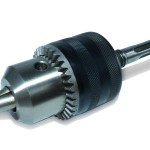 To lock accessories in place simply pull the chuck’s sleeve back, insert the bit as far as it will go (turning it may help it to slip into position), and release the sleeve. The bit should not be able to fall out but should be able to slip back and forth.
To lock accessories in place simply pull the chuck’s sleeve back, insert the bit as far as it will go (turning it may help it to slip into position), and release the sleeve. The bit should not be able to fall out but should be able to slip back and forth.
For standard drilling into wood and metal where a hammer drill is not required, 13mm (1/2”) keyed chuck adaptors are available with an SDS shank on them, and will slip in and lock straight into an SDS chuck.
These adaptors are not designed to support masonry drilling on these drills. Apart from the inability of the adaptor and regular masonry drill bits to withstand the forces of a rotary hammer’s pneumatic hammer action, the forces will simply dislodge the bit from the keyed chuck.
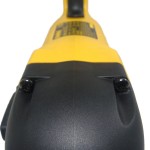 Housing
Housing
The housing of a drill is the casing that protects the internal components. Rotary hammer drills will typically have a jampot housing.
A jampot housing is where the internal components of the drill are inserted into the housing and then a lid (usually an alloy casing) is screwed down to seal it. This durable style of housing is generally used on high quality power tools, and is much more effective at keeping the internal components aligned and the power tool structurally sound.
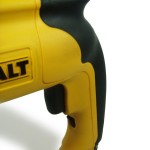
These drills may also have anti-vibration technology built into the housing, which helps to prevent frequent users from acquiring severe conditions such as Hand Arm Vibration Syndrome (HAVS).
Handle Of A Rotary Hammer Drill
The handle is the component of the drill that you hold with your dominant hand and is what you use to apply pressure to the drill.
Light duty rotary hammer drills usually have a pistol-grip handle, and heavier duty units will nearly always have a D-handle.
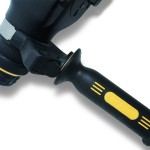 Side Handle
Side Handle
This handle is designed to stop rotation and to provide stability for the user. It is secured just behind the chuck and can be positioned at various angles to the body. The angle is generally changed by unscrewing the handle, moving it, and screwing it back up.
On rotary hammer drills it is common for side handles to have shock absorbing capabilities, in order to quell excessive vibrations during use.
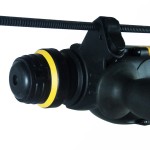 Depth Stop
Depth Stop
The depth stop is a small plastic or metal rod that sits in the side handle, and can be set to certain lengths in front of the drill to monitor the depth of holes.
This is especially useful if you are drilling holes where the drill cannot go through the material or if you need to drill holes of a certain depth.
Rotary Hammer Drill Accessories
For a comprehensive guide to the accessories that can be used in rotary hammer drills, please see our separate drilling accessories section.
What Rotary Hammer Drill To Buy
When purchasing a rotary hammer drill, decide what features are most important to you (from the features above) and make sure these are included in your final purchase. The main considerations you should make include how much power you require, the size and weight of the tool, whether you need it to be cordless, and how often you will be using it.
A rotary hammer drill should really be capable of drilling the largest hole into masonry you will ever need to drill. It should also be comfortable to use, and should be of very solid construction. Remember to ensure it is a three-mode model if you require a tool for light chiselling and breaking requirements.
Manufacturers will either direct their products at the DIY or professional market. DIY tools are designed for home use and generally include plenty of features for a very modest price. They also tend to have very generous warranty periods, including replacement warranties. Professional tools are designed for commercial use and are built for durability, performance, and reliability. Their warranty periods tend to be much shorter than DIY tools, and are exclusively repair warranties. The main advantage of these tools is that they should well outlive their warranty period, and if they require repair and maintenance spare parts are readily available.
The price of any tool will depend on the quality, capabilities, and features of the model. Bear in mind that at least one of these three elements is commonly sacrificed by manufacturers to reduce the tool’s price and increase its sales. After all, price is the most important factor for consumers.
Rotary hammer drills can cost anywhere from $50 to $500.
It is important to bear in mind that the entire cost of any power tool is not just it’s initial purchase cost. Added costs can include accessories for the tool to function, maintenance, downtime, and replacement costs. Buying according to your requirements will help to keep these costs to a minimum.
See Full Range Of Cordless Rotary Hammer Drills
See Full Range Of Corded Rotary Hammer Drills
To browse manufacturers of rotary hammer drills, please select a company from our list of power tool manufacturers.
The Best Rotary Hammer Drill Machines in Australia
This Makita SDS drill boasts three drilling modes, while delivering a low 14.5 m/s2 of vibration — ideal for your longer work projects. Furthermore, a welcome drill depth gauge ensures accuracy even when operating at the full 1100 rpm.
As a cordless rotary hammer drill, its 18-volt power cell (not included) offers convenient portability, while a grunty 1.9 joules of energy permits concrete-busting impact energy.
The DHR202Z Makita incorporates a front-mounted LED lamp, increasing its adaptability in low-light conditions. Intelligently-designed rubber joints reduce hand tremor — while an electric brake prevents accidents and material damage.
Pros
Cons
Its control enhancing — although modest 680 rpm — speed permits the unit to knock out a grunty 4800 bpm. Making it possibly the best rotary hammer drill for tile removal and wall demolition.
A sub-compact build allows effortless access to more confined areas, such as inside cupboards and beneath floor joists. And, this Makita rotary hammer machine arrives at just 2.2 kg (without cell) — boosting endurance on longer jobs.
Its 360-degree secondary handle elevates accuracy. Furthermore, as a Makita brushless rotary hammer drill, the efficient motor permits extended life from its lithium-ion cell.
Pros
Cons
DEWALT DCH263N-XJ Review

Its 1400 watts of brawn delivers a speedy 1165 rpm together with an impact rate of 4300 bpm. A high-lumen LED lamp provides precision-boosting illumination in low-light conditions, while the DEWALT SDS hammer drill’s D-handle enables effortless overhead use.
With 28 mm of concrete penetration ability, it excels on masonry work and renovation jobs. Furthermore, this unit boasts an active vibration control handle — keeping oscillation to a relatively low 9.1 m/s2, increasing comfortable operation time.
Pros
Cons
Although only offering two modes — rotation, and rotation and hammer — making it less than ideal for demolition, its rapid 1600 rpm of turning power enables speedy drilling. Furthermore, patented XPT Technology shields against dust and moisture ingress — increasing the durability of this rotary hammer.
While offering impressive speeds and grunt, the unit remains pleasingly lightweight at 2.5 kg with the cell attached. That, combined with the DHR165Z’s 12 m/s2 of vibration means elevated stamina, crucial for longer projects.
Unfortunately, this Makita cordless rotary hammer drill doesn’t arrive with the required 18-volt battery — but does come complete with a depth gauge and removable side handle.
Pros
Cons
No rotary hammer drill bits included.
Makita DHR242Z Review

Its 4700 bpm of impact promises rapid penetration. When combined with its three modes, it permits effortless drilling, rotation with hammer, and chiselling capabilities.
The DHR242Z Makita features optional in-built dust extraction — ensuring that your work area remains clear of dust and debris. Furthermore, rubber joint tech minimises hand oscillation — reducing fatigue and boosting work endurance.
The Makita SDS drill 18v knocks out a steady 950 rpm, while its efficient brushless motor enhances battery life. A one-touch SDS chuck system allows for effortless bit exchange, while easy-grip handles ensure accuracy and comfort.
Pros
Cons
The Bosch GBH18V-26DN specs suit both the pro-user and serious DIYer — with a solid 890 rpm and substantial 4350 bpm. And, with rotation, rotation with hammer, and hammer-only modes — it’s as suitable for drilling as it is chiselling.
A front-mounted LED lamp ensures your work areas remain reassuringly illuminated, while enhanced kickback tech protects both the unit and your wrists. And, the generous three-finger trigger of the GBH18V-26DN Bosch reduces digit fatigue — crucial on long projects or vertical work.
Pros
Cons
The suitably rapid output of 1350 rpm will be sufficient for most drilling requirements, while its hefty grunt of 5000 bpm delivers speedy hammer and demolition action. And, while the M18CHP-0 Milwaukee may not arrive with a cell — a compatible 18-volt M18 FUEL battery will have extended run time due to the brushless motor.
Mighty 4.5 joules of energy make this Milwaukee rotary hammer excel on stubborn masonry. Furthermore, low 8.6 m/s² of vibration keeps user fatigue to a minimum.
Pros
Cons
Metabo BH 18 LTX BL Review

Our Rating: 4.6
Although the unit knocks out a steady 730 rpm, it’s a rapid hammer drill — delivering around 5250 bpm. That said, with only two modes — rotation only, and rotation with hammer — it’s not ideal for pure chiselling applications.
Brushless motor tech boosts battery efficiency, while patented MVT (Metabo VibraTech) reduces both work damage and user fatigue. An integrated LED lamp provides welcome illumination to your target material, and a specialised electronics system ensures a consistent speed — even under heavy loads.
A substantial secondary handle enables both comfort and accuracy, although the single-finger trigger system may lead to digit stress on longer jobs.
Pros
Cons
Its 2.6 joules of impact energy, combined with a 3950 bpm output, promises efficient and speedy chiselling and demolition abilities. Especially when selecting the hammer-only function from the three-mode system.
Trademarked Reactive Force Control (RFC) shields against tool overload — protecting both its internal motor and your wellbeing. Furthermore, constant speed control ensures a consistent 1050 rpm output — even with the DH18DBL experiencing heavy load demands.
Although a hefty machine at 3.7 kg (with battery), the HiKOKI SDS Plus drill offers comfortable and fatigue-busting operation — through its padded main handle, hand-slip protecting secondary handle, and two-finger trigger.
Pros
Cons
Katana 220002 Review

Three modes offer impressive versatility, whether drilling timber, boring into concrete, or chiselling masonry. At 1850 rpm, it’s a rapid machine — while the 4800 bpm output delivers speedy impacts.
An incorporated LED lamp supplies crucial light onto your target material, and a rotating secondary handle enhances control and comfort. Knocking out 2 joules of energy, it’s a pleasingly powerful drill — although the lack of an included cell is a downer.
The Katana’s 18 mm of concrete drilling capacity should be sufficient for most casual operators, and its generous two-finger trigger enables heightened user stamina.
Pros
Cons
Rotary Hammer Drill Operating Tips
The following tips will help to preserve the life of your rotary hammer drill, increase your efficiency, and most importantly, keep you safe.
- If the bit jams because the power tool is overloaded or it becomes wedged in your work, switch the power tool off immediately. Because of this, you should always prepare yourself for a sudden reaction force when drilling by taking a firm stance and holding the tool with two hands.
- You should never change the direction of drive whilst the tool is still operating, as it is highly likely you will damage the tool’s gears.
- Always wait until the machine has come to a complete stop before placing it down.
- Only use rotary hammer drill’s for short periods of time and with work gloves, as the vibrations they produce can seriously damage your hands and arms.
Personal protective equipment (PPE) must always be worn when operating power tools. For more information on PPE and power tool safety, click here.
Was this guide helpful? Has anything been left out? Are there any improvements that could be made? Please take a moment of your time and click here to provide your valuable feedback.
Conclusion — The Best Cordless SDS Hammer Drills
Cordless SDS Rotary Hammer Drills offer serious grunt and versatility — able to cope with plastics, hard timber, metal, and masonry.
Our top picks above represent the ultimate rotary drills in Australia. Whether the budget-focused Katana 220002, the overhead work targeting Bosch GBH18V-26DN, or the remarkably lightweight Metabo BH18 LTX BL — there’s a unit suitable for every price point, user experience, and project requirement.
However, undoubtedly the pinnacle of power and performance has to be the Makita DHR202Z.
Offering a welcome balance between speed and impact — it’s the consummate all-rounder. Three drilling modes offer work flexibility, while substantial rubber jointing safeguards against tremor and vibration.
Agreed, depending on your particular needs, this unit may not be ideal. But for pros and prosumers demanding durability, versatility, and grunt with a drill from a leading manufacturer — few rotary hammer drills can beat the Makita DHR202Z.
ToolCobber.com.au is a participant in the Amazon Services LLC Associates Program, an affiliate advertising program designed to provide a means for sites to earn advertising fees by advertising and linking to Amazon.com. Additionally, ToolCobber.com.au participates in various other affiliate programs, and we sometimes get a commission through purchases made through our links.

